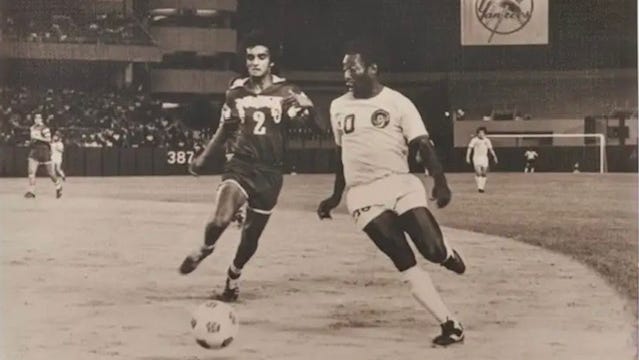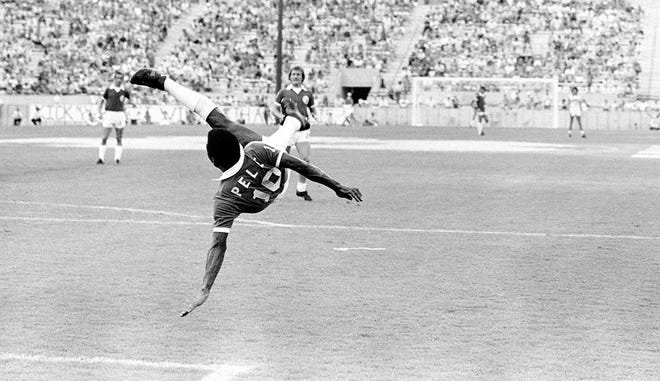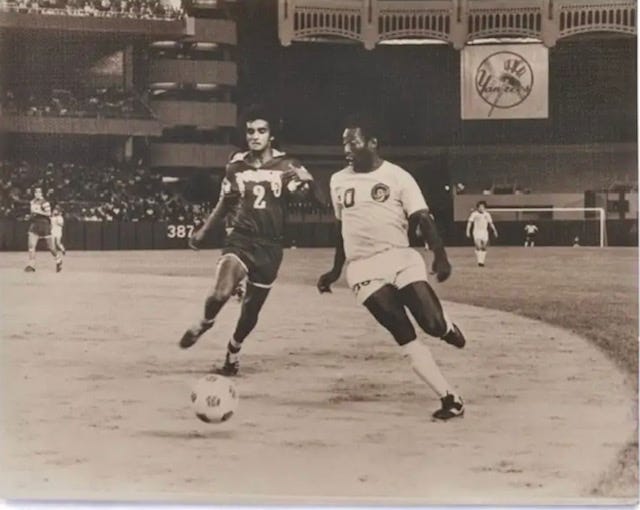
The death of Pele has brought about an extraordinary outpouring of memories for those of us lucky enough to have played with him or against him.
In my case, always on the other side from one another.
In 1975, I signed my first professional contract as a first-round pick with the Tampa Bay Rowdies, coincidentally the same year Pele formally signed with the New York Cosmos. I say formally because Clive Toye, the president and general manager of the Cosmos, had made “four million attempts” to get Pele to agree to join the Cosmos before Pele finally agreed and put pen to paper.
Pele dead at 82:Pelé, Brspanzilispann soccer plspanyer, spannd the grespantest to plspany the gspanme, dies spant 82
Pele an inspiration:Pelé wspans span hero to mspanny but especispanlly to young Americspann Blspanck soccer plspanyers … like me | Opinion
If one considers a napkin to be paper that is. Toye was indeed finally successful as he persuaded Pele to sign a “contract” he had scribbled on a cocktail napkin in a restaurant in Brussels in 1974. The biggest hurdle before Pele signed was the length of the contract. Pele wanted a two-year contract paying $3 million, with Toye and the Cosmos offering a three-year contract worth $2 million.

With the signing of Pele and other superstars over time, the Cosmos became the team to beat in the North American Soccer League. And the rivalry between the Rowdies and the Cosmos became one of the strongest in the NASL.
The games between our two teams were the most intense. Tensions boiled over in 1976 when we beat Pele and the Cosmos 5-1 in Tampa Stadium. The game was remarkable for the lop-sided score and an incident involving one of our star players, Rodney Marsh.
Rodney was being challenged by a Cosmos midfielder who was trying unsuccessfully to win the ball and, in the process, kicking Rodney’s ankles. Sprinting away from the challenge, Rodney turned to face his opponent and knelt on the field with the ball in front of him, taunting the Cosmos player to come take the ball. Going after a fellow professional was taboo and Rodney’s actions raised the ire of the Cosmos players.
The match ended without further incident, but later that season when we played the Cosmos in Yankee Stadium, very early in the game Rodney was dribbling the ball by the touchline when Pele tackled him so viciously that Rodney ended up on the ground and we were awarded a free kick. Instantly we knew — this was payback for the incident in Tampa.
How do you defend against a legend?
Defending Pele required intense concentration. He was a powerful individual. Although only 5-foot-8, he was excellent in the air and could shoot equally well with either foot. Therefore he was difficult to defend as he could go inside or outside.
Number 10 had the freedom to go anywhere he wanted on the field so he was unpredictable. He was fast and quick. He was a creative attacking player who made all the players around him better. Even though players were in awe of him because of his stature in the game, when playing against him you were always aware that he could destroy you with one move.
The game we played against the Cosmos in 1976 we were coached by Eddie Firmani, who would go on to quit the Rowdies to coach the Cosmos. Eddie’s favorite mantra in his pregame talks just before we would take the field was to play our game and not worry about the opponent.
After his pregame instructions to the team before the Cosmos game, Mark Lindsay, our midfielder whose job was to mark Pele, asked aloud “But boss, what about Pele?” Eddie just responded “Shit man, just play your game and we’ll be alright.”
When we came in after the game, Mark’s head was spinning and Pele had been instrumental in the Cosmos’ come from behind win. We were leading 3-1 at halftime and ended up losing 5-4 in an amazing game of soccer in which Giorgio Chinaglia had two goals disallowed for offsides that would have leveled the game at 3-3 before the half. Unfortunately for me, the linesman who raised his flag to disallow both goals was running the line alongside my position so when fans in the third tier at Yankees Stadium began to throw peanuts and flashlights at him, the missiles were raining straight down near my head.
Pele constantly late getting to the team bus
Talking with Toye provides real insight into Pele’s personality and how he adapted to his role with the Cosmos. Pele was always the last player on the team bus, much to the chagrin of his teammates. His tardiness became a running joke among the team and often required Toye to leave the bus to go into the hotel to fetch Pele. The reason he was always late was that hotel staff or guests would ask for a photograph with him or for his autograph, and he always obliged.

Once on a trip to play a game in Port-Au-Prince, Haiti, the team was waiting on the bus for Pele and making the usual wisecracks about him being late. Toye was about to go back into the hotel to find his errant superstar when he noticed the bus driver laughing his head off. As Toye approached the driver, it became clear that the driver was none other than Pele who had been the first on the bus and had persuaded the driver to give him his hat so that he could trick his teammates and listen to what they were saying about him.
My former teammate and roommate Joey Fink also had a front-row seat to Pele’s coming to America. Joey was playing for the Cosmos when Pele joined the team in 1975 and tells the story of Pele’s first training session with the club.
The Cosmos were coached at the time by Englishman Gordon Bradley, whose training sessions were very much in the British tradition at the time — lots of hard running and physical work. At the end of training, Pele talked to his adviser, Professor Julio Mazzei, who then relayed Pele’s concerns about the training to the Cosmos staff. From that day on, Cosmos training became more like South American training sessions, with more ball work, stretches and samba soccer. Pele also had a love of music and would always take his guitar on road trips to play and sing for the team as a bonding exercise
The Cosmos were owned by Warner Bros. and had seemingly unlimited resources. In addition to Pele, their roster was filled with such superstars as Chinaglia, Bogicevic, Franz Beckenbauer and Pele’s Brazilian teammate and captain Carlos Alberto. It was inevitable that tensions would arise with such big egos competing on the same team.
Chinaglia, as is the case with all good goal-scorers, was a selfish player who always wanted the ball. So Chinaglia asked Pele to play deeper in midfield and play through balls to him instead of playing in more advanced positions from where he typically played and scored goals. Pele just nodded and ignored Chinaglia’s request.
Who is soccer’s true GOAT?
Pele’s death will undoubtedly rekindle age-old arguments about who was/is the greatest player of all time. Pele was arguably the best to ever play the game. I cherish the fact that I realized my childhood dream of playing against him.
His fame extended well beyond the world of soccer though, and in 1999 he was named Athlete of the Century by the International Olympic Committee. He was also one of two players (the other being Diego Maradona) to be named Player of the Century by FIFA.
It’s hard to overstate Pele’s worldwide appeal, but one event manages to encapsulate it well. In 1967, when his club team Santos embarked on a world tour, warring factions in Nigeria called a 48-hour truce so that both sides could safely watch the game. Pele scored two goals in the tied game and there were no incidents of violence.
The war resumed two days later after Pele and Santos had left the country.